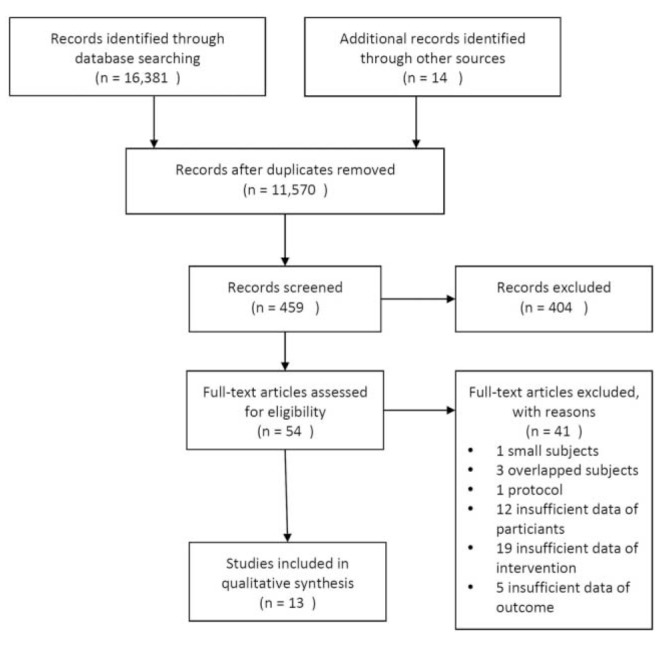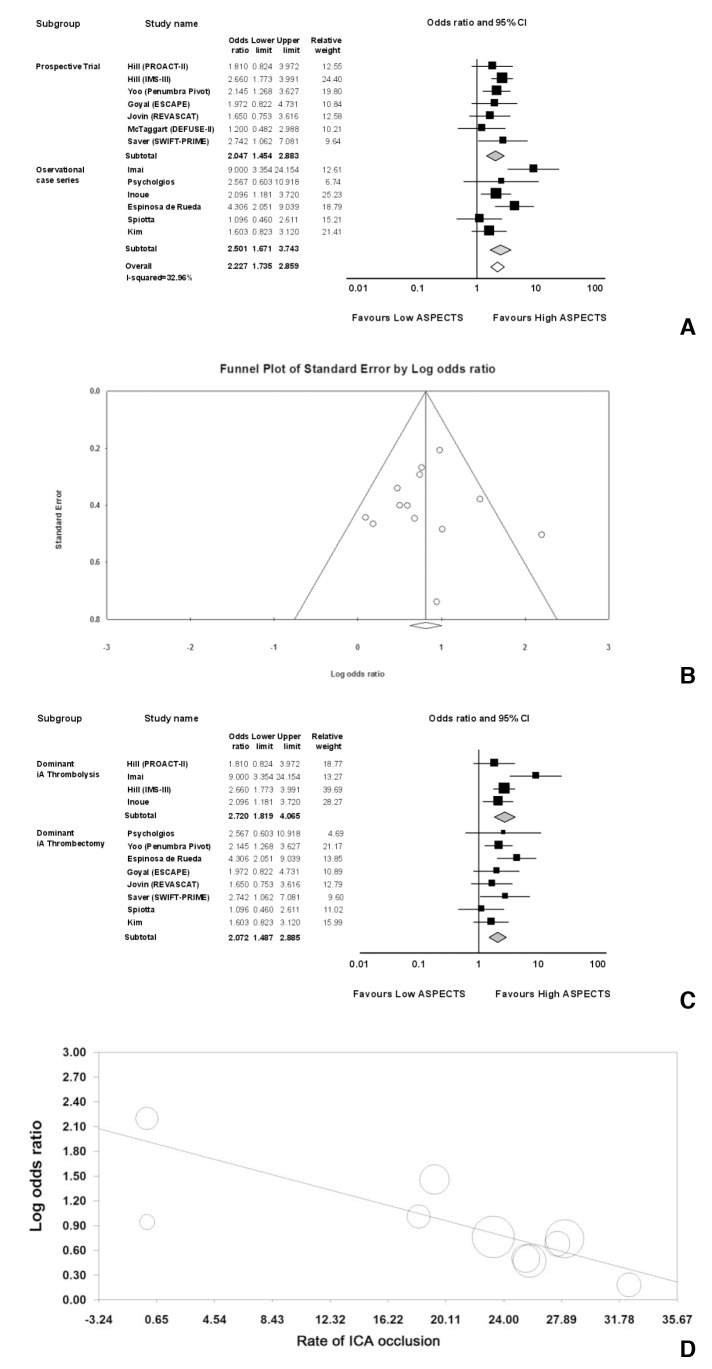Neurointervention.
2017 Mar;12(1):20-30. 10.5469/neuroint.2017.12.1.20.
Alberta Stroke Program Early CT Score in the Prognostication after Endovascular Treatment for Ischemic Stroke: A Meta-analysis
- Affiliations
-
- 1Department of Radiology, Kyung Hee University Hospital at Gangdong, School of Medicine, Kyung Hee University, Seoul, South Korea. md.cwryu@gmail.com
- 2Department of Neurosurgery, Kyung Hee University Hospital at Gangdong, School of Medicine, Kyung Hee University, Seoul, South Korea.
- 3Department of Neurology, Kyung Hee University Hospital at Gangdong, School of Medicine, Kyung Hee University, Seoul, South Korea.
- 4Department of Radiology, Gangnam Severance Hospital, Yonsei University College of Medicine, Seoul, South Korea.
- KMID: 2371755
- DOI: http://doi.org/10.5469/neuroint.2017.12.1.20
Abstract
- PURPOSE
The Alberta Stroke Program Early CT Score (ASPECTS) was devised to quantify the extent of early ischemic changes in the middle cerebral artery territory on brain CT. We performed a systematic review and meta-analysis of studies that presented clinical outcomes and baseline ASPECTS in ischemic stroke patients managed with endovascular methods to validate the use of ASPECTS for risk prognostication.
MATERIALS AND METHODS
We searched the MEDLINE, EMBASE, and Cochran databases for observational or interventional studies that reported clinical outcomes and baseline ASPECTS in ischemic stroke patients treated with endovascular methods. Data were pooled to perform a meta-analysis for comparisons of clinical outcomes between high and low ASPECTS patients.
RESULTS
A meta-analysis of 13 studies (six observational and seven interventional) revealed favorable outcomes (mRS sore 0-2 at 90 days) for high baseline ASPECTS (odds ratio=2.22; 95% CI: 1.74-2.86).
CONCLUSION
High ASPECTS is a predictor of favorable outcome after endovascular therapy for ischemic stroke.
Keyword
Figure
Cited by 1 articles
-
Cell free DNA: A Novel Predictor of Neurological Outcome after Intravenous Thrombolysis and/or Mechanical Thrombectomy in Acute Ischemic Stroke Patients
Atulabh Vajpeyee, Teddy Wijatmiko, Manisha Vajpeyee, Onjal Taywade
Neurointervention. 2018;13(1):13-19. doi: 10.5469/neuroint.2018.13.1.13.
Reference
-
1. Berkhemer OA, Fransen PS, Beumer D, van den Berg LA, Lingsma HF, Yoo AJ, et al. A randomized trial of intraarterial treatment for acute ischemic stroke. N Engl J Med. 2015; 372:11–20. PMID: 25517348.2. Campbell BC, Mitchell PJ, Kleinig TJ, Dewey HM, Churilov L, Yassi N, et al. Endovascular therapy for ischemic stroke with perfusion-imaging selection. N Engl J Med. 2015; 372:1009–1018. PMID: 25671797.
Article3. Goyal M, Demchuk AM, Menon BK, Eesa M, Rempel JL, Thornton J, et al. Randomized assessment of rapid endovascular treatment of ischemic stroke. N Engl J Med. 2015; 372:1019–1030. PMID: 25671798.4. Jovin TG, Chamorro A, Cobo E, de Miquel MA, Molina CA, Rovira A, et al. Thrombectomy within 8 hours after symptom onset in ischemic stroke. N Engl J Med. 2015; 372:2296–2306. PMID: 25882510.
Article5. Saver JL, Goyal M, Bonafe A, Diener HC, Levy EI, Pereira VM, et al. Stent-retriever thrombectomy after intravenous t-PA vs. t-PA alone in stroke. N Engl J Med. 2015; 372:2285–2229. PMID: 25882376.
Article6. Larrue V, von Kummer R, del Zoppo G, Bluhmki E. Hemorrhagic transformation in acute ischemic stroke. Potential contributing factors in the European Cooperative Acute Stroke Study. Stroke. 1997; 28:957–960. PMID: 9158632.7. von Kummer R, Allen KL, Holle R, Bozzao L, Bastianello S, Manelfe C, et al. Acute stroke: usefulness of early CT findings before thrombolytic therapy. Radiology. 1997; 205:327–333. PMID: 9356611.
Article8. Fiorelli M, Bastianello S, von Kummer R, del Zoppo GJ, Larrue V, Lesaffre E, et al. Hemorrhagic transformation within 36 hours of a cerebral infarct: relationships with early clinical deterioration and 3-month outcome in the European Cooperative Acute Stroke Study I (ECASS I) cohort. Stroke. 1999; 30:2280–2284. PMID: 10548658.9. Pexman JH, Barber PA, Hill MD, Sevick RJ, Demchuk AM, Hudon ME, et al. Use of the Alberta Stroke Program Early CT Score (ASPECTS) for assessing CT scans in patients with acute stroke. AJNR Am J Neuroradiol. 2001; 22:1534–1542. PMID: 11559501.10. Hill MD, Buchan AM. Canadian Alteplase for Stroke Effectiveness Study I. Thrombolysis for acute ischemic stroke: results of the Canadian Alteplase for Stroke Effectiveness Study. CMAJ. 2005; 172:1307–1312. PMID: 15883405.
Article11. Yoo AJ, Zaidat OO, Chaudhry ZA, Berkhemer OA, Gonzalez RG, Goyal M, et al. Impact of pretreatment noncontrast CT Alberta Stroke Program Early CT Score on clinical outcome after intra-arterial stroke therapy. Stroke. 2014; 45:746–751. PMID: 24503670.
Article12. Espinosa de Rueda M, Parrilla G, Manzano-Fernandez S, Garcia-Villalba B, Zamarro J, Hernandez-Fernandez F, et al. Combined Multimodal Computed Tomography Score Correlates With Futile Recanalization After Thrombectomy in Patients With Acute Stroke. Stroke. 2015; 46:2517–2522. PMID: 26219650.
Article13. Spiotta AM, Vargas J, Hawk H, Turner R, Chaudry MI, Battenhouse H, et al. Impact of the ASPECT scores and distribution on outcome among patients undergoing thrombectomy for acute ischemic stroke. J Neurointerv Surg. 2015; 7:551–558. PMID: 24916415.
Article14. Stroup DF, Berlin JA, Morton SC, Olkin I, Williamson GD, Rennie D, et al. Meta-analysis of observational studies in epidemiology: a proposal for reporting. Meta-analysis Of Observational Studies in Epidemiology (MOOSE) group. JAMA. 2000; 283:2008–2012. PMID: 10789670.15. Barber PA, Demchuk AM, Zhang J, Buchan AM. Validity and reliability of a quantitative computed tomography score in predicting outcome of hyperacute stroke before thrombolytic therapy. ASPECTS Study Group. Alberta Stroke Programme Early CT Score. Lancet. 2000; 355:1670–1674. PMID: 10905241.16. Seyyedi S, Cengiz K, Kamasak M, Yildirim I. An object-oriented simulator for 3D digital breast tomosynthesis imaging system. Comput Math Methods Med. 2013; 2013:250689. PMID: 24371468.
Article17. Higgins JP, Altman DG, Gotzsche PC, Juni P, Moher D, Oxman AD, et al. The Cochrane Collaboration's tool for assessing risk of bias in randomised trials. BMJ. 2011; 343:d5928. PMID: 22008217.
Article18. Hill MD, Rowley HA, Adler F, Eliasziw M, Furlan A, Higashida RT, et al. Selection of acute ischemic stroke patients for intra-arterial thrombolysis with pro-urokinase by using ASPECTS. Stroke. 2003; 34:1925–1931. PMID: 12843342.
Article19. Imai K, Mori T, Izumoto H, Watanabe M, Kunieda T, Takabatake N, et al. MR imaging-based localized intra-arterial thrombolysis assisted by mechanical clot disruption for acute ischemic stroke due to middle cerebral artery occlusion. AJNR Am J Neuroradiol. 2011; 32:748–752. PMID: 21292794.
Article20. Psychogios MN, Schramm P, Frolich AM, Kallenberg K, Wasser K, Reinhardt L, et al. Alberta Stroke Program Early CT Scale evaluation of multimodal computed tomography in predicting clinical outcomes of stroke patients treated with aspiration thrombectomy. Stroke. 2013; 44:2188–2193. PMID: 23715960.
Article21. Hill MD, Demchuk AM, Goyal M, Jovin TG, Foster LD, Tomsick TA, et al. Alberta Stroke Program early computed tomography score to select patients for endovascular treatment: Interventional Management of Stroke (IMS)-III Trial. Stroke. 2014; 45:444–449. PMID: 24335227.22. Inoue M, Olivot JM, Labreuche J, Mlynash M, Tai W, Albucher JF, et al. Impact of diffusion-weighted imaging Alberta stroke program early computed tomography score on the success of endovascular reperfusion therapy. Stroke. 2014; 45:1992–1998. PMID: 24923724.
Article23. McTaggart RA, Jovin TG, Lansberg MG, Mlynash M, Jayaraman MV, Choudhri OA, et al. Alberta stroke program early computed tomographic scoring performance in a series of patients undergoing computed tomography and MRI: reader agreement, modality agreement, and outcome prediction. Stroke. 2015; 46:407–412. PMID: 25538199.24. Kim SK, Yoon W, Park MS, Heo TW, Baek BH, Lee YY. Outcomes Are Not Different between Patients with Intermediate and High DWI-ASPECTS after Stent-Retriever Embolectomy for Acute Anterior Circulation Stroke. AJNR Am J Neuroradiol. 2016; 37:1080–1085. PMID: 26767711.
Article25. Goyal M, Menon BK, Coutts SB, Hill MD, Demchuk AM. Effect of baseline CT scan appearance and time to recanalization on clinical outcomes in endovascular thrombectomy of acute ischemic strokes. Stroke. 2011; 42:93–97. PMID: 21088240.
Article26. Schriger DL, Kalafut M, Starkman S, Krueger M, Saver JL. Cranial computed tomography interpretation in acute stroke: physician accuracy in determining eligibility for thrombolytic therapy. JAMA. 1998; 279:1293–1297. PMID: 9565011.27. Dzialowski I, Hill MD, Coutts SB, Demchuk AM, Kent DM, Wunderlich O, et al. Extent of early ischemic changes on computed tomography (CT) before thrombolysis: prognostic value of the Alberta Stroke Program Early CT Score in ECASS II. Stroke. 2006; 37:973–978. PMID: 16497977.28. Demchuk AM, Hill MD, Barber PA, Silver B, Patel SC, Levine SR, et al. Importance of early ischemic computed tomography changes using ASPECTS in NINDS rtPA Stroke Study. Stroke. 2005; 36:2110–2115. PMID: 16166579.
Article29. Badhiwala JH, Nassiri F, Alhazzani W, Selim MH, Farrokhyar F, Spears J, et al. Endovascular Thrombectomy for Acute Ischemic Stroke: A Meta-analysis. JAMA. 2015; 314:1832–1843. PMID: 26529161.30. Chen CJ, Ding D, Starke RM, Mehndiratta P, Crowley RW, Liu KC, et al. Endovascular vs medical management of acute ischemic stroke. Neurology. 2015; 85:1980–1990. PMID: 26537058.
Article31. Coutts SB, Hill MD, Demchuk AM, Barber PA, Pexman JH, Buchan AM. ASPECTS reading requires training and experience. Stroke. 2003; 34:e179. author reply e179. PMID: 12970512.
Article32. Nogueira RG, Liebeskind DS, Sung G, Duckwiler G, Smith WS, Merci , et al. Predictors of good clinical outcomes, mortality, and successful revascularization in patients with acute ischemic stroke undergoing thrombectomy: pooled analysis of the Mechanical Embolus Removal in Cerebral Ischemia (MERCI) and Multi MERCI Trials. Stroke. 2009; 40:3777–3783. PMID: 19875740.
- Full Text Links
- Actions
-
Cited
- CITED
-
- Close
- Share
- Similar articles
-
- Collateral Circulation in Ischemic Stroke: An Updated Review
- Visibility of CT Early Ischemic Change Is Significantly Associated with Time from Stroke Onset to Baseline Scan beyond the First 3 Hours of Stroke Onset
- Intravenous Thrombolysis and Endovascular Thrombectomy in Acute Ischemic Stroke with Minor Symptom
- Application of Machine Learning and Deep Learning in Imaging of Ischemic Stroke
- Penumbral Imaging-Based Thrombolysis with Tenecteplase Is Feasible up to 24 Hours after Symptom Onset





